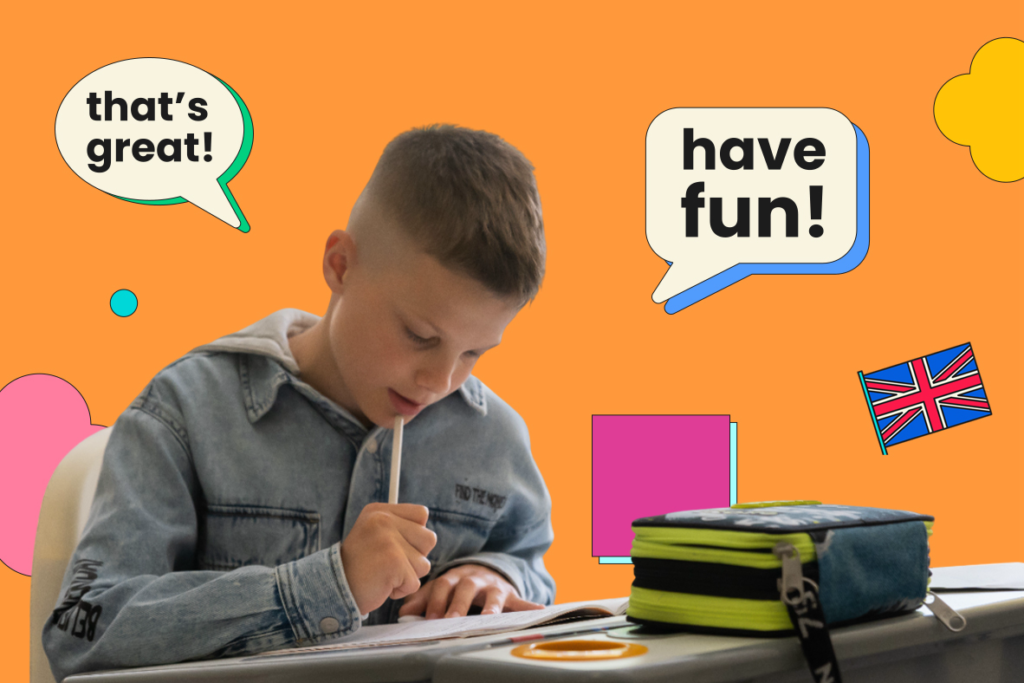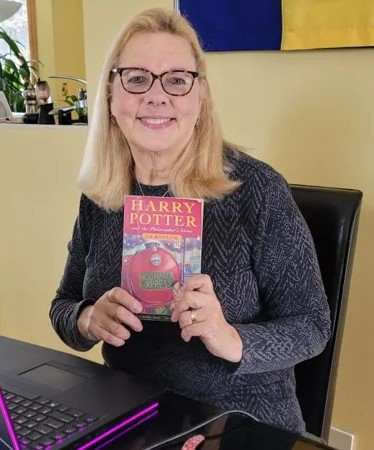

How can an English teacher get children talking? What exercises are effective and fun, and how can pupils fight shyness? Anna Robinson (United Kingdom), Setsuko Toyama (Japan), Sherry Grazda (USA), and Julia Wowkodaw (Canada) — volunteer teachers of our «Ukraine Speaks English» project, shared their teaching tips.
Setsuko Toyama’s exercises
Setsuko Toyama is an English teacher, trainer and material writer from Japan. She has taught various age groups, taught at a university, conducted workshops in Japan and overseas, and published textbooks and teacher resource books. Her recent publications are «Beehive/Buzz Starter Student Book and Workbook,» 2023, Oxford University Press. Setsuko Toyama works with children from primary school.
Next — Setsuko Toyama’s direct speech.
«Dear Teachers,
I’m very happy to share with you a few ideas and activities that might make your preparation easier and make your lessons more fun.
Idea #1: PRAISE and RECAST
Praise children for speaking up, even uttering one word of English. You might like to list up praising words and phrases and practice saying them aloud with feelings before your lessons. “Good! Great! Lovely! Excellent! Perfect! Wonderful! Good job! Good English!”
After you praise the student for speaking up, you might like to recast what they have said.
Teacher: What fruit do you like, Maria?
Child: Apple.
Teacher: Good English! Do you like apples? (Nod and say slowly.) «I like apples.»
Related Activity: Slow Reveal
If you have some flashcards, you need no preparation. Cover a flashcard/picture card with a sheet of paper. Start to move and lower the paper slowly and ask the children, «What’s this?» Keep sliding the paper down. Stop a few times and ask children, «What’s this?»
This can be a phonics activity. Print the initial letter at the top and the whole word at the bottom.«Let’s see if you can guess what picture I have. The word starts with a «p» [pi:], and its sound is p [p]. I’ll show you the picture slowly. Listen to the hints. We use it to write. Some are long, and some are short. What’s this? Pencil? Good thinking. Yes, it’s a pencil. Let’s say it together [p], [p], pencil. Excellent, everyone!»
Idea #2: PUPPETS
Use a puppet as your teaching assistant. I have a bear named Oliver when I teach children. I can model a dialog with Oliver. I can introduce Oliver and have children listen to 3rd person narrative. I can encourage children to ask Oliver questions. If a child asks a question in their mother tongue, I ask Oliver in English and Oliver «whispers» the answer. Then I tell the children what he said in English.
Children love using puppets as a puppeteer. Give a child one sock (unused!) and two circular adhesive stickers. Have children draw two eyes, one each on a sticker, and put them on the sock. Have children speak to their partner using the sock puppet. You can also have children put eyes on their pencil case or anything a child can hold easily in one hand. The children in the photo had a speaking activity as a hungry caterpillar, walking around the classroom and saying: «I’m hungry. I want to eat ( ).»
Idea #3: QUESTIONS
Change the types of questions to make it easy for children to answer and speak up. There are three types of questions: Wh questions, Yes/No questions, and choice questions. Let’s say you’re going to read The Very Hungry Caterpillar by Eric Carle in your lesson.
The following are the questions you might ask about the first double page spread and the answers you expect.
What do you see in the picture? (The moon, a tree, a leaf, an egg)
Do you see the moon/a tree/a leaf/an egg? (Yes.)
Is it morning or night? (Night.)
Wh questions are challenging if children do not have enough vocabulary yet.
Yes/No questions are less challenging, if you point to the picture as you speak and nod for Yes and shake your head for No.
Choice questions are easiest if you give the correct answer as the second choice. Children hear the correct answer and repeat it.
Idea #4: ROUTINE
Set up a routine and keep to it. It provides children with feeling of safety and trust. A song or a chant to start the English lesson will help children to turn on their English-speaking mode. In my online lessons on Tuesdays, I start with a good morning song, using the melody of Happy Birthday. «Good morning to you. Good morning to you. Good morning, dear children/dear teacher/Ukraine! Good morning to you.»
Related Activity: Pointing Chant
A chant is like a song without a melody. Chant the following rhyme and do the movement. Children point to the objects and say the English words aloud and settle down for the lesson:
Point to the ceiling.
Point to the floor.
Point to the window.
Point to the door.
Clap your hands together, one, two, three.
Now sit down and look at me.
Happy teaching!».
Tips from Sherry Grazda
Sherry Grazda is an English teacher from the USA. She taught all grades pre-K through 7th over 30 years, and also served as a reading specialist before creating the GRAZDA CENTER. Sherry has also trained literacy coaches, presented numerous workshops across the country, and mentored many colleagues and student teachers in her schools and districts. Sherry received peer-nominated honors, including a regional Excellence in Teaching Award and an award for State of California Geography Teacher of the Year. Sherry Grazda works with children from middle school.
Next — Sherry Grazda’s direct speech.
«These ideas came from videos by Chris Westergaard, who is the director and founder of The Language House in Prague. His videos have been helpful to me in my teaching even though I have a masters degree in teaching learners of English.
Eliciting
One important thing to do when teaching English is to elicit words from students. In other words, we need to bring the vocabulary and information out of students by teaching a concept they already understand, but in another language. Eliciting allows participation and involvement of all students. In contrast, translation is not helpful. The goal is to get meaning across as efficiently and accurately as possible. There are different eliciting techniques, depending on the vocabulary you are teaching, for example, concrete nouns or more abstract verbs. Some of my favorite eliciting techniques are:
- pictures and drawings — these are good for concrete nouns
- miming (acting out) — this is good for action verbs, adjectives and adverbs
- realia (using real objects) — this is great for concrete words as well
- hyponyms — for example, show a knife, fork and spoon to introduce the word ‘cutlery’
CCQ (Concept/Check/Question)
Instead of asking «Do you understand?» which students might answer with a «yes» even though they don’t understand yet, there are ways for a teacher and students to have fun and check for understanding at the same time.
With vocabulary that has been introduced, for example, with animals and where they live, a teacher can say, «Do polar bears live in the jungle?» Students show they understand the vocabulary by responding «No, polar bears live in the arctic, not in the jungle». As another example, for beginning learners of English, if a teacher has introduced types of clothing, they can point to a drawing of a pair of shorts and say «Jacket?» The students can respond by saying, «No, shorts!»
When teaching grammar, after some practice, a teacher might check for understanding by saying to students, «I am to wear pants?» The students would correct this by saying, «I am wearing pants». The teacher can then know that students understand the present continuous structure».
Tips from Anne Robinson
Anne Robinson is an ELT blogger, author, teacher trainer and consultant from the United Kingdom, now lives in Spain. She has worked as a teacher and a director of language schools in Madrid and Santander. She has also been a speaking examiner and trainer for the Cambridge exams and has spoken at conferences and events around the world, including twice in Ukraine. Anne Robinson works with children from middle and high school.
Anne has written several coursebooks for Cambridge («Fun for Starters», «Movers and Flyers», «Fun Skills 3 and 5», «Exam Booster for C1 Advanced») as well as versions for Linguist Ukraine (Prepare 6, 7 and 8) and supplementary materials (Prepare Around the World, ZNO Practice Tests and others).
Next — Anna Robinson’s direct speech.
How to help a child talk in English
«First and foremost, I would say that not forcing any child to speak is important. Some children are naturally shyer than others. They might not feel like speaking about a particular topic or perhaps for some reason, on a particular day. It’s important to build their trust and confidence and create an atmosphere where they don’t feel exposed.
If you’re asking them to share something that’s very personal, then you should do the same. Let them know that you’re human. You make mistakes and find things tricky too. A big smile and encouraging intonation can go a long way to inspiring students to speak and participate.
Also, if you’re expecting students to speak, think about the language they might need. You can help by pre-teaching key language, or by displaying it on a board or screen. Also, allow them to rehearse if necessary. Get them to say words or sentences in their heads, in a whisper, sing it or shout it!
Two of my favourite tasks, which always seem to work are:
Using the alphabet
Recently, we spent several lessons on our «ABC of me». Each word of the exercise starts with an alphabet letter, and children have to answer about their favorite things in alphabetical order. (The original idea was for one lesson, but the students were so inspired and all wanting to speak, that it went on for four X one hour lessons!). The students were all wanting to share their answers, their letters.
My favourite/ideal …
- artist
- book
- city
- day of the week
- English word
- fashion accessory
- gadget
- historical figure
- ice cream
- job
- kind of music
- lunch
- musical instrument
- number
- ocean
- place
- quote
- recipe
- smell
- tradition
- uplifting song
- view
- weather
- year
I also like to use the alphabet when I’m brainstorming a topic, or revising it. I ask them to try and think of a word for each letter of the alphabet.
Like animals for example. ant, bear, camel, deer, elephant, frog, giraffe, horse, insect, jaguar, kangaroo, lion, monkey, newt, octopus, panda, queen bee, rabbit, sheep, tiger, umbrella bird, vulture, whale, x-ray tetra, yak, zebra
*You can add an extra layer of challenge by asking them to think of a word that they think no one else will have thought of.
«ABC of me»
Two truths and a lie
To add an extra challenge and fun, ask students to write 3 sentences about themselves. (*I find if you give them time to think, then the sentences are much more imaginative).
Two of their sentences are true, and one is false. The sentences can be around a topic (e.g. hobbies) and/or on a grammar area (e.g. can).
For example.: I can swim. I can sing. I can play the guitar.
(In my case, I can swim and sing, but I can’t play the guitar …. yet! So, the third sentence is my ‘lie’!)».
Pieces of advice from Julia Wowkodaw

Julia Wowkodaw is a teacher of modern languages and ESL from Canada. She has a BA in French Language and Literature from the University of Toronto and a B Ed from the University of Calgary. Before she retired, Julia Wowkodaw was the Languages Department Head and the International Students Coordinator at the high school level. Julia Wowkodaw works with children from middle and high school.
Next — Julia Wowkodaw’s direct speech.
«How do you get students engaged in language learning? Over my years of teaching English and French to non-native speakers, I found that the key is to make the language relevant to their interests.
Students get a lot of practice in reading and writing in the target language at school, so the challenge is to get them to listen and especially speak in that language.
For ESL students, this is particularly easy as pop culture from the English-speaking world is incredibly popular. Whether it’s music, film, videogames, or social media, students like to know about what is popular with their peers. In my classes, we would practice all the language strands every day. And the philosophy we practiced in my school district was «No strand alone». So, for instance, I would pair a short video with a written response or a small group discussion.
When I started volunteering with Smart Osvita, I began reading easy high-interest books with the students. I would prepare a Google slide deck that included background context to the story, questions for them to think about for that day’s chapter, definitions for difficult vocabulary or idioms, an online game related to the book, and a discussion question that would engage them and their interests.
The Harry Potter series was the most popular suggestion of what to read next. Many of the students had read the books, mostly in Ukrainian, but some in English. Many of the students speak English, from intermediate to advanced levels. I suspect that the students who join our sessions and don’t participate in discussions are beginners. All are welcome to contribute, as I understand how difficult it can be to get over the shyness of speaking in another language. I speak some Ukrainian, but having a moderator to translate is extremely helpful. Into the lesson I incorporate a Kahoot game which most of the students play. The competitive yet anonymous nature of the game is very attractive to students. Students enjoy creating avatars and handles, as well as bragging about their success. We finish with a discussion related to the chapter. They often know more than I do about Harry Potter!
I have gotten to know some of my students very well as they have been reading with me since Book 1 and we are now on Book 4. I have grown very fond of them, but I am always glad to have new students discover our reading club».
The aim of «Ukraine speaks English» project is to provide free English-speaking meetings for Ukrainian children, not only to enhance language skills but to show support from all over the globe, to give a safe space and community, and to offer opportunities for acquiring new knowledge and engaging in enjoyable activities.
We engaged 170 teachers+ – volunteers from Canada, Australia, Portugal, Austria, Turkey, USA, Spain, Japan, Іndia.
We are proud and grateful to every volunteer who supports Ukrainian children and believes in us. The project «Ukraine Speaks English» is implemented by the NGO «Smart Osvita» in partnership with «Classrooms Without Walls»/Teachers for Ukraine.



